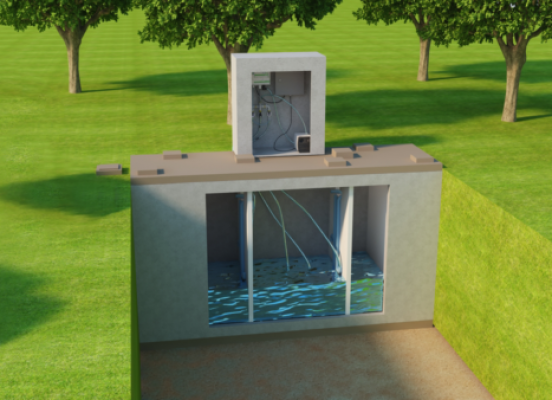SBR Based Sewage Treatment Plant
SBR is a high-performance solution for wastewater treatment that can successfully handle batch and continuous flow operations. It is a proven technology with minimal costs and maintenance requirements. Due to high removal capacity and versatility, it is compliant with stringent discharge standards. Biological process and high-quality product generation are the distinct qualities of SBR based sewage treatment plant.
Due to streamlined design, Cleantech SBR small Sewage Treatment Plant is one of the most favored wastewater treatment systems today. This highly flexible technology is useful in a wide variety of applications.
What is SBR Based Sewage Treatment?
SBR process is a widely used water treatment method in the developed countries from quite a long time. It has become popular in India, China, and other Asian countries in the recent years. When sewage is sent to the SBR Tank (also known as Reaction tank) one batch at a time, an activated sludge process gets activated. Timed sequence of operations occurs in the SBR tank and water gets purified. Here is the timed sequence if events:
-
Filling
It is the first stage of the process where the influent wastewater is filled in the first tank. It is important that the water gets filled with a controlled yet rapid flow so that the Food to Microorganism Ratio remains appropriate. It is similar to the selector mechanism which ensures sufficient growth of microorganisms that have better settling characteristics.
-
Aeration
In the reaction stage, microorganisms use Ammonia, Nitrogen or BOD (Biochemical Oxygen Demand). The degree of treatment is directly proportional to the sludge mass and the time taken for aeration. It also depends on the strength of the wastewater (or the level of impurities) and the degree of nitrification. It is the rate of conversion of Ammonia into nitrate or nitrite of less toxicity.
-
Settling
Settling takes around 60 minutes to 90 minutes depending on the number of cycles per day. In this process, aeration stops and sludge gets settled. Cleat, effluent water gets accumulated over the sludge blanket.
-
Decanting
Decanting is the process of removing the effluent from the tank without disturbing the sludge settled at the bottom.
-
Idling
Idling is the waiting time between two filling cycles.
-
Sludge Wasting
When sludge gets accumulated beyond a threshold level, it has to be discharged from the system. Sludge wasting process controls the quality of effluent water and the population of microorganisms. Two parameters are adjusted to keep better control over the quality of sludge wasting.
✦ Mixed liquor suspended solids (MLSS)
✦ Mean cell residence time (MCRT)
SBR Tank acts as the aeration tank in the reaction stage when activated sludge and influent water are mixed under aerated conditions. It also works as the secondary clarifier during two stages; settling stage and decanting stage. Mixed liquor is again allowed to settle, and the overflow moves to the next stage of treatment. In the Sludge Return System, after settling in the SBR tank, influent gets mixed with sludge return system again. However, in this case, the feed is transferred to the sludge and not vice-a-versa.
Usage and application
SBR based sewage treatment plant is ideal for several applications:
- It is the best suitable system for heavy loads of industrial or municipal wastewater. SBR process is ideal for both cold and warm climates.
- Streamlined design keeps equipment and operating costs optimized.
- It can be upgraded easily in a cost-effective manner.
- Meets requirement of cleaning effluents without getting affected by prevalent conditions.
- Around 98 percent removal of TSS and BOD, reduction of Phosphorus and Nitrogen in one step.
Qualities That Stand Apart SBR Sewage Treatment Plant From Others
- It is highly operator friendly due to maximum automation and minimum human intervention. Due to PLC based monitoring and control system, it is an advanced and smart system.
- The system is flexible by supporting continuous feed, as well as true batch operations, flow control strategies.
- It is resilient to extraneous water infiltrations. Hence, it is ideal for wastewater collection network. It is capable of handling organic as well as hydraulic variations.
- Meets effluent discharge limits consistently.
- It is advantageous than other systems as far as the initial capital investment versus operational cost is concerned. Thus, it offers the best life cycle.
Application and Usability
Due to high versatility and cost-effectiveness, SBR sewage treatment plant is widely used in:
- Personal bungalows, houses and weekend homes
- Hotels, resorts and holiday homes
- Hospitals
- Malls and shopping centers
- Airports and railway stations
- Commercial and residential complexes
- Project sites
- Schools, colleges, and other institutions
- Small, medium and large manufacturing units
- Municipal Gardens
- Sports complexes
- Other public places
Cleantech SBR system is preferred in widespread applications because of its capability of giving the best results in the wide variation of flows. Less operator assistance and high efficiency make it the top-preferred wastewater management system.
To know more, please check Cleantech.

